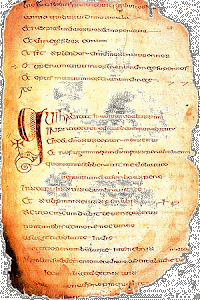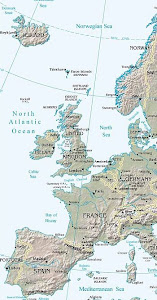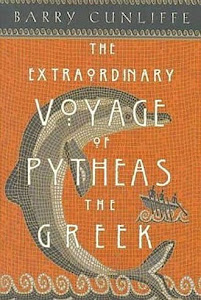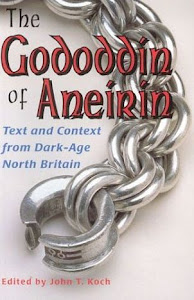But if Arthur was a Scot or Pict or North Briton (take your pick from the available theories), where would his ‘Camelot’ or main court be located? If he was a Scot, i.e. from NE Ireland, it would be somewhere in the Scots colony of Dál Riada on the west coast, perhaps at the hillfort at Dunadd, when the Scots first took it over from the Picts, or at Dunstaffnage, which a 1612 account claims was once home to the Coronation Stone known as the Stone of Destiny; or on Iona, where St Columba set up his base to convert the Picts and Scots. If he was a North Briton, it could be at Dun Edin (Edinburgh) or Alt Clud (Dumbarton Rock), both capitals of then Brittonic kingdoms which stretched between the Firths of Forth and Clyde and across Southern Scotland down to the Borders. And if our northern King Arthur was a Pict, it could be up near Inverness, or perhaps over at Scone on the east coast, or Dunadd (see above) on the west coast, for Highland topography split the Pictish confederation into two or more separate kingdoms.
Each site (there are other nominees) has its champions: for instance, Edinburgh has a hill overlooking the country’s present capital palace at Holyrood, called Arthur's Seat; near Stirling was an ex-Roman fort with a similar-sounding name to the Romances’ “Camelot” (which in French had a silent “t”): Camelon; Alt-clud, alias Dumbarton (“Fortress of the Britons”) on the Clyde below Loch Lomond, was referred to as Castello Arturius, or Arthur's Castle, in an 11C document, while some locals claim Loch Lomond was formerly called “The Lake" (as in Lancelot of ~).
But the site that became the coronation centre of the amalgamated Celtic (Scots-Pict-North Brittonic) kingdom of Alba (Scotland) was Scone (rhymes with “boon”), just outside the city of Perth on the east coast. There from the 9th C AD stood the original coronation throne where the kings of this amalgamated kingdom were crowned. It held the fabled Stone Of Scone, alias the Stone Of Destiny. Today at Scone there is only a replica to satisfy the visitor, for the whereabouts of the original is uncertain. (As the Palace of Scone’s advertising puts it, “Here you can see where the Stone of Scone once stood and ponder on the tantalising mystery of where it might be today.”)
Here we run into a centuries-old mystery that remains unsolved perhaps because none of the major vested interests wants it solved, publicly anyway, in case the verdict goes against them. Officially, the Stone Of Scone or Stone Of Destiny, is on view in Edinburgh Castle, having been returned there in 1996 to end Scots nationalist agitation over this hijacked coronation relic. (As it is used in coronations, it is officially just on loan; the plan is to return it to Westminster for the next one, when the Queen dies.) This 26” x 10” x 16” sandstone block sat under the coronation chair when every English monarch was crowned from the time of Edward I, who ordered it taken south in 1296 to discourage the Scots from the idea they could crown their own kings. (That didn’t stop them, of course.)
It was briefly returned to Scotland when 4 nationalist students took it from Westminster Abbey at Xmas 1950. They were never prosecuted for fear of stirring up even more anti-English feeling and public demonstrations – and of having the Crown’s claim to own the Stone Of Destiny challenged in open court. The story of the 1950 escapade is told by the coup’s original Ian Hamilton, then a law student in Glasgow, who went on to become a QC or Queen’s Counsel – though he refused to take the oath of allegiance in its original form on the grounds it was historically dishonest. His 1952 book has just been reissued to tie in with the release of the film Stone Of Destiny last year, just out on DVD.
.jpg)
Our northern King Arthur sat here? Not very likely. The chair itself is only 13C, and the stone it holds may not be what it seems. This is the same image used in the film Stone Of Destiny.
A final mystery remains, however: as there in fact more than one stone? If so, is the official stone a substitute? For some time, rumours have been circulating this is the case. This is the suspicion (or claim) that Edward I was given a substitute, i.e. the unprepossessing slab of sandstone you can see in Edinburgh Castle was simply a lavatory cesspit or cistern cover – a great joke on the English monarchy. A secondary issue re the stone’s identity has also been raised: the thesis here is that the stone returned to Westminster by the police after the Xmas 1950 escapade was a 20C manufactured substitute. This has been the claim of several people who were on the periphery of the 1950 incident, that one of the replicas that were being fashioned around this time was sent back to London. One of the items of evidence cited is a considerable weight discrepancy between the present, official 336 lb stone, and the c450 lbs referred to in Hamilton’s memoir and an Abbey account from when it was cleaned earlier the same year.
Ian Hamilton himself still says the same stone was returned, and that he’s sick of these stories. As it has long been argued that an earlier substitution was made, this would have meant one fake was replaced with another, i.e. a real, monastic-era cesspit cover was replaced with a 20C replica of one. Such a modern substitution of one fake for another would have made little sense for anyone who knew the story - as I believe nationalists would. Of course, it may be a simple intended nationalist PR coup, to get around the fact that the fake, the cesspit cover taken to England in 1296 is claimed as the real Stone. Revealing that a substitution was made in 1950 would overcome this, and thereby promulgate the idea that if the present Queen, or perhaps her successor, was not crowned on the authentic Stone, then she or he cannot legally be the monarch.
Shortly after the Stone Of Destiny DVD arrived in the post, I flew up to Scotland to check out a few things. One was to see what was claimed about the stone in the various editions of the book itself, which gives its known back history. Geological testing of the red sandstone block doesn’t show much, and for answers we have to rely on references in historical sources – which is of course our metier here. Mediaeval codex manuscript accounts from around the time of its move south do describe its existence and function, and sometimes its appearance, e.g. “Apud Monasterium de Scone positus eat lapis pergrandis in ecclesia Dei, juxta manum altare, concavus quidam ad modum rotundae catherdeaie confectus, in quo future reges loco quasi coronatis” (“In the monastery of Scone, in the church of God, near to the high altar, is kept a large stone, hollowed out concave as a round chair, on which their kings were placed for their ordination, according to custom.” - Walter, Canon of Guisborough Priory, Yorkshire, early 14C). Note the use of the present tense here in describing the stone as being kept at Scone, implying Canon Walter is reproducing an earlier account from before 1296. The chronicler, sometimes known as Walter De Hemingford, reportedly had been present at the coronation of John Balliol at Scone in 1292, so the description would date from then.
The antiquarians who flourished from the 18C onward also tended to claim this was the same ritual stone that had been used for similar purposes by Irish kings crowned at Tara. They called it the Lia Fáil, which was in legend brought to Eire by a ‘fairy’ people, the Tuatha Dé Danann ('people of divine Ana'). Lia Fáil is usually translated as The Speaking Stone. This is in support of a myth that it would roar or scream when the rightful new king stood or sat on it. But I can’t find any stories in the ancient Irish tales where this miracle actually happens as it should. (Also, the replica seems to be a pillar stone, rather like a modern Ordnance Survey trig point marker.) What happens in one tale I’ve come across is that it doesn’t speak, and the proposed king’s foster-father, the champion Cúchulainn, angrily splits it (almost a variation on the Arthurian “sword in the stone” motif). In another tale, the hero Conn of the Hundred Battles hears it roaring, but this is when he treads on the forgotten half-buried stone, and a druid tells him the number of roars is the number of kings who will succeed him at Tara. But when the Irish set up their colony in the Inner Hebrides, they took the Lia Fáil Stone to ratify their separate kingdom there.
 Lia means stone (there is a similar word in geology, lias) but the translation of fáil as ‘speaking’ doesn’t feel right to me – more like a back-explanation based on the context being misconstrued. Ireland as the home of the Lia Fáil is sometimes given the poetic name in Gaelic of Inis Fáil, translated as Isle Of Destiny. The same stem also seems to occur in Gaelic Fáilte, which you can see all around Scotland (and Ireland) as the tourist organisations use it, for it means Welcome[s] . This would make more sense if it was meant to be an inaugural stone welcoming the new king, and he could speak his oath standing on or holding it, and so take up his “destiny.”
Lia means stone (there is a similar word in geology, lias) but the translation of fáil as ‘speaking’ doesn’t feel right to me – more like a back-explanation based on the context being misconstrued. Ireland as the home of the Lia Fáil is sometimes given the poetic name in Gaelic of Inis Fáil, translated as Isle Of Destiny. The same stem also seems to occur in Gaelic Fáilte, which you can see all around Scotland (and Ireland) as the tourist organisations use it, for it means Welcome[s] . This would make more sense if it was meant to be an inaugural stone welcoming the new king, and he could speak his oath standing on or holding it, and so take up his “destiny.”If we also consider tales promoted by the 19C British Israelite Movement (which claimed the Celts were one of the Bible’s 10 Lost Tribes), there’s also a Biblical tiein legend the Lia Fáil was originally Jacob’s Pillow stone, mentioned in Genesis, where Jacob dreamt his vision of a ladder to heaven. Like Jacob’s Ladder, Jacob’s Pillow became a symbol of inspiration and blessing, and it was used as a politico-religious token in establishing the original nation-state named Israel, after Jacob’s second, “divine” name. Supposedly the stone then became the pedestal stone of the Ark (as in Raiders Of The Lost ~), and went to Egypt, then Spain, then Eire.
Founding legends cited in Hector Boece’s 16C Chronicles of Scotland name Egypt and Spain as where key founders came from, with Scotia supposedly named after a Pharaoh’s daughter named Scota. But how or why the stone would’ve ended up at Tara is not really explained in the legend beyond a tale of Scota and her husband fleeing from the Egyptian Plagues. It sounds like another attempt by Irish monastic writers to depict a pagan relic as a Christian one via a vague Biblical link. The Lia Fáil also was alternatively identified as St Columba’s altar stone, but this is equally unsourced and unprovable. The sandstone block now in Westminster is similar to the sandstone still found locally around Scone Abbey, which gives the cesspit-cover theory the edge. That would also explain why Edward’s men returned in 1298 to ransack Scone, and why the Scots declined later English offers to return the Stone. (Both sides have remained tight-lipped about this.)
The current film tie-in edition of Ian Hamilton’s account of taking the Stone Of Destiny in 1950 has an intro by Scotland’s First Minister, Alex Salmond, who as might be expected, does not advance any controversial theories about rival Stones there. But around the same time [June 2008], Salmond (who studied mediaeval history) publicly announced he believed the original Stone was switched in 1296 - that the Westminster Stone is a fake. (In an online readers’ poll in The Times, more than half agreed with the First Minister.) The original 1952 edition of the Hamilton book, which I found in the library up there, No Stone Unturned, has a different foreword, by Sir Compton Mackenzie. (If you don’t know who he was, he was a Scots writer best known for Whisky Galore, who also liked to snipe at officialdom. He also wrote a 1940s novel, The North Wind Of Love, on an unsuccessful 1932 attempt to recover the Stone Of Destiny to bury it in Scotland.) He comments that the stone we know was probably part of ‘the red sandstone used for the gateway of Dunstaffnage Castle’.
But if the official one is indeed a substitute, what happened to the original one, the stone alluded to in the earlier references - the one on which early princes like our putative northern Arthur would have sworn their oath? There are a couple of anecdotes in the Scottish press of people stumbling into caves in eastern Scotland and seeing a stone throne with carvings on it. The odd thing is that in a couple of old accounts (which I haven’t seen myself directly yet) the Stone described is quite dissimilar in appearance to the familiar sandstone block. This is odd, because if you want to fob someone like a victorious king (Edward I) off with a replica trophy, it should at least resemble the original. For Edward and his staff would have been sure to have heard descriptions of it.
But the rival mediaeval codex accounts give the ‘authentic’ Stone as respectively [1] made of black stone (basalt) and [2] made of white marble! Seemingly we have three Stones Of Destiny. Besides the fake discussed, perhaps one was the Irish Lia Fáil, and the other the coronation stone of the Picts? Ian Hamilton QC has also written two volumes of memoirs, and the Foreword to the first, A Touch Of Treason, by the Scots historian and novelist Nigel Tranter (who helped return the Stone in 1951) says he has no doubt the Westminster stone is a fake, as the real Stone, the Lia Fáil, is described as a marble chair. (Presumably he got this from mentions of it in mediaeval codexes like the 14C chronicle of Robert of Gloucester, which has it as being of “whyte marble ston”.) That would leave the black basalt stone as the Pictish one.
Nationalist groups (including a modern Scottish Knights Templar organisation) have hinted in the past that they still possess the “original” (whatever that means), and that will surface at the appropriate moment in Scotland’s history, when it is about to take up its own destiny as an independent modern nation. (I met someone who was told as much when visiting Roslyn Chapel for a seminar.) This being Scotland’s Homecoming Year, hopefully more news of this long sought-after talisman will surface.





